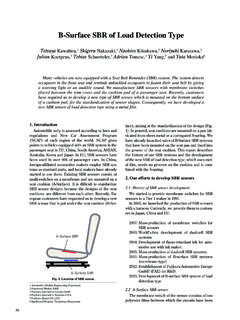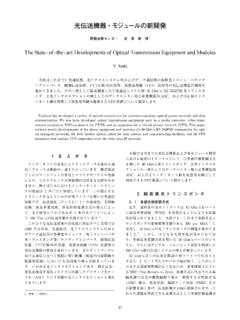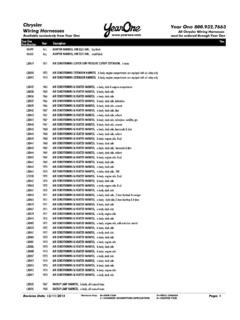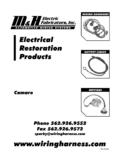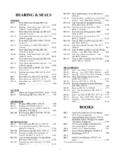Transcription of Wiring harnesses for Next Generation …
1 Fujikura Technical Review, 201377 Wiring harnesses for next Generation AutomobilesKiyotsugu Oba1 The weight of a Wiring harness is increasing year by year because of newly added functions. In recent years, there are growing customer demands for environmentally friendly products, such as high-voltage Wiring harness systems, for hybrid electric vehicles (HEVs) and electric vehicles (EVs) and weight-saving Wiring harnesses systems designed to improve fuel efficiency. In order to satisfy these customer demands, we are developing a high-voltage Wiring harness system and weight-saving electric wire and connection technology for a weight-saving Wiring harness system. Although the gross weight of the Wiring harness using a conventional electric wire is about 30 kg/car, weight savings of about 30% is possible by using a weight-saving electric PrefaceVarious new technologies for the environment, safe-ty and comfort are applied to recent cars.
2 In terms of Wiring harness development, environmentally friendly products, such as hi-voltage Wiring harness systems for HEVs and EVs and weight-saving Wiring harnesses systems designed to improve fuel efficiency, are in strong demands. We are working on researching and developing to contribute to the environment through construction of a low-carbon society. This report de-scribes the developments of high-voltage Wiring har-ness systems for HEVs and EVs and lightweight wires, main components for the lightweight Wiring harness Hi-voltage Wiring harness Development resultWe have developed products for ecological vehicles (eco-car, green-car), mainly for EVs since the early 1990s. Car manufacturers also have put new cars into market in rapid sequence since the late 1990s.
3 High-voltage Wiring harness systems differing from conven-tional 12 V systems are needed for developments of ecologically friendly cars. We have supplied our high-voltage Wiring harnesses to 5 car manufacturers and over 10 system suppliers for more than 10 years as a result of our collaborative development efforts with them from the early development tests of the electric car prototype with our wir-ing harness started in 2005. After actual operations, Fuji Heavy Industries Ltd. decided to install Fujikura s high-voltage Wiring harnesses into Plug-in Stella and put them on the market in 2009 ( ).Figure 2 shows the system outline of Plug-in Stella. Figure 3 shows the appearance of the high-voltage wir-ing harness for Plug-in Stella. We manufacture the 1 Automotive Products R&D DepartmentFig.
4 1. Plug-in 2. System boxDC/DC ConverterJunction boxBatteryHigh-voltagebattery moduleMotor/GeneratorInverterHeaterCharg e connectorAir conditionerDCDCAC78whole high-voltage Wiring harness system of a car, in-cluding a junction box and the inner Wiring system of the battery 2010, Fujikura joined an industry-academia-gov-ernment project of Keio Univ., Isuzu Motors Ltd., Ka-nagawa prefecture, and other companies, Research and Development of Electric Low and Full Flat Floor Bus (ELFB), and contribute to the development through supplying high-voltage cables. The bus has been under verification test in Kanagawa prefecture since 2011 with the aim of putting it to practical use ( , ). Connectors for high-voltage Wiring harnessTo satisfy various customer requirements, our line-up of the connectors offers FHVC-Mark I, a connector for individual shielded wires and FHVC-Mark II and FHVC-S, connectors with common braided shield that combines multiple non-shielded wires into one 1).
5 Furthermore, connectors for individual shielded wires are available in two types: a pair of male and female connectors for connecting between wire harness and component/equipment ( ), and bolt-on type connector that is directly bolt-ed to the inside of electric equipments with its termi-nals ( ).Theses connectors feature a rating voltage of 600 V, seal ability of 98 kPa and shield performance higher than 40 dB. The contacts of the female connector itself has a rotating structure with a main conductor that al-lows multiple contacts for a large current as well a ro-tatable contact for braided shield. These features im-proved the workability of installing a thick cable to a car shield connectors (FHVC-MarkII and FH-VC-S) reduced their parts number, achieved light-weight, cost reductions, and improved productivity by wrapping its multiple non-shielded wires.
6 We have two types of connectors, a high-current connector for high-voltage main systems of 15 to 20 sq (mm2) wires ( ) and a low-current connector for electric equipment of 3 to 5 sq wires ( ). Handling of braided shield wire is the key technical point. With contraption on the structure of the joint between braided wire and con-nector, this connector allowed productivity improve-ment as well as , Acronyms, and Hybrid Electric VehicleEV Electric VehicleWH Wiring HarnessCA wire Copper Clad Aluminum wireFig. 4. Electric Low and Full Flat Floor 5. High-voltage 3. High-voltage Wiring for equipmentsJunction boxcablesin a batterymodulevoltage monitoring cordsDC main WHAC motor WHFujikura Technical Review, 2013793. Lightweight electric wireIn the past, weight savings and thinning of automo-tive wires, from AV to AVS to AVSS to CAVUS(CHFUS, CIVUS), have been achieved through contraption mainly for thinning insulation material and devising conductor structures including circular compressed structure 2).
7 But newer techniques are required as the former technology is approaching its developed three types of new wires that will en-able further reductions in weight and diameter accord-ing to their usage by reducing the specific gravity of conductors and strengthening them. One is an alumi-num alloy automotive wire with high strength and high conductivity, another is copper-clad aluminum (CA) wire suitable for a thick wire such as a battery cable, and the last is a high strength wire suitable for signal lines that have the same strength with the one-quarter cross section to that of a current soft each conductor material has a suitable applica-tion area, we can get a maximum effect of weight and wire size reductions by using them depending on the sizes as shown in Table Automotive Aluminum alloy wiresAn aluminum alloy wire is suitable for electric cir-cuits smaller than sq (mm2) as low specific gravity materials.
8 We set a goal of developing a conductor with equivalent or better electrical and mechanical characteristics compared with those of a copper wire. We also pay attention to terminal connecting strength required for an automotive wire along with electrical characteristics. Material characteristics required to at-tain the goal are Tensile strength 140 MPa or higher, Elongation 10 % or higher and Conductivity 58 % or higher. To achieve these objectives, based on various data of aluminum alloys, we selected the most effec-tive strengthening method and succeeded in obtaining the material characteristics exceeding the marks fi-nally (Table 2). It is known that aluminum alloy wires require different manufacturing processes from those of a conventional copper wire. We collaborated with the manufacturing department, and succeeded in its production.
9 As a result of these contraptions, the wires have world top-level balance of tensile strength, extensibili-ty, and conductivity as automotive aluminum wires. Figure 10 shows the cross section of the aluminum al-loy 6. FHVC-Mark I (Connector type).Current wire size sq(mm2)Developed wire size sq(mm2)Suitable wire strength wireHigh strength/High ~ ~ wireLow density/High strength3 or larger5 ~ 100CA wireHigh conductiv-ity/Low densityTable 1. Current wire and suitable light weight electric wire 8. FHVC-Mark II (Under Development).*under developmentFig. 7. FHVC-Mark I (Bolt-on type).Fig. 9. strength(Mpa)Elongation(%)Conductivity(% IACS)marks140 or higher10 or higher58 or 2. Characteristics of aluminum alloy Automotive copper-clad aluminum (CA) wiresCopper-clad aluminum (CA), a low gravity material, is suitable for a wire of a cross-section over sq.
10 As shown in Fig. 11, CA wires have a structure of an alu-minum core conductor and copper cladding layer, and have both characteristics of copper s good conductivi-ty and aluminum s high specific gravity-conductivity ratio. Also CA wires of mm diameter that is nor-mally difficult to process with a pure aluminum wire can be produced without any problem. Aluminum wire-terminal connections also have some difficulties in manufacturing. CA wires, however, have copper surface and thus enables electric connection by crimp-ing using conventional terminals for copper wires, as shown in Figure 12, which means no additional invest-ment needed. Using a CA wire in a thick cable results in a cable of light weight, thick but flexible, and high are the only one CA wire supplier in Japan. We have enough experience of manufacturing from the base material to the conductive wire and High-strength thin wire for automobilesSeveral attempts have been made to use various ma-terials except copper for thin electric wires designed specifically for signal lines.







